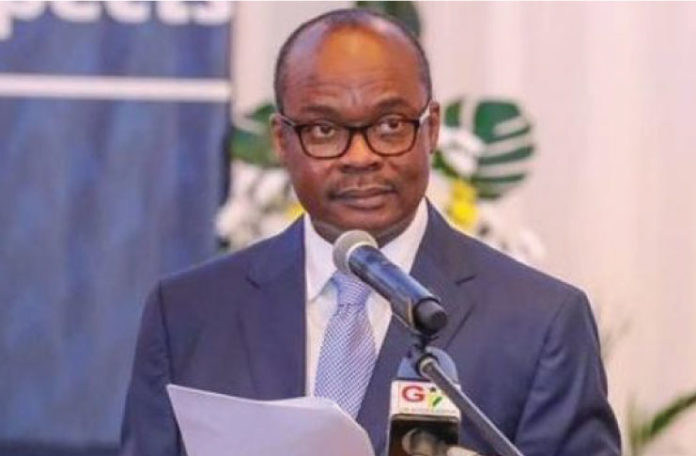
Ghana has recorded a trade surplus of US$584.5 million, according to provisional trade data for the first two months of 2018, the governor of the Central Bank has said.
The figure which represents 1.1% of Ghana’s Gross Domestic Product (GDP) said Dr Ernest Adisson was a result of higher export receipts from the country crude oil.
“This compares with a trade surplus of US$494.3 million (1.1% of GDP) recorded over the same period in 2017,” he stated at a press conference Monday.
The trade surplus, he noted, is expected to translate into a current account surplus in the first quarter of 2018, and further into a strong external position.
He continued that due to a drawdown in international reserves largely reflecting seasonal foreign exchange flows, planned sovereign bond coupon payments and Energy Sector Levy Act (ESLA) related payments, Ghana’s Gross International Reserves (GIR) stood at US$6.9 billion (3.8 months of import cover) as at March 20, 2018 compared to US$7.6 billion (4.3 months of import cover) as at December 2017.
On the foreign exchange market, he said it has remained calm over the first quarter of 2018 on the back of subdued demand pressures alongside improved foreign exchange liquidity and that cumulatively, the local currency has appreciated by 0.2 percent against the US dollar, in the year to March 23, 2018, compared with a depreciation of 5.0 percent during the same period in 2017.
2017 growth momentum dovetails into 2018
According to the governor, since the last MPC (Monetary Policy Committee) all of the Bank’s core measures of inflation broadly declined, suggesting subdued underlying inflation pressures. The Bank’s main measure of core inflation, which excludes energy and utility he said declined from 12.6 percent in December 2017 to 11.3 percent in February 2018.
“Also, the weighted inflation expectations by businesses, consumers and the financial sector derived from the Bank’s surveys continued to decline indicating that inflation expectations remain well anchored towards the medium term target of 8±2 percent,” he observed.
He thus noted that “initial evidence from high frequency indicators show that the growth momentum experienced in 2017 has continued into 2018” with the Bank of Ghana’s Composite Index of Economic Activity (CIEA) growing by 3.1 percent year-on-year in January.
He further pointed out that the Bank’s confidence surveys conducted in February also indicated positive sentiments on growth prospects, realization of business expectations and general improvements in the economy.
“The pace of growth in key monetary aggregates has continued to moderate consistent with contained aggregate demand pressures. Annual growth in total liquidity slowed to 12.5 percent in January 2018 from 26.7 percent a year ago (also partly reflecting the reduction in the number of banks in the monetary survey from 34 to 32).
“There is also a gradual downward migration of all money market interest rates, as well as re-alignment of the yield curve in line with the monetary policy stance since March 2017.”
The interbank rate, the rate at which commercial banks lend to each other, he disclosed declined further to 18.3 percent in February 2018 from 19.3 percent in December 2017 and 25.2 percent a year ago as the interest rates on money market instruments also declined, especially at the short-end of the market.
In February 2018, rates on the 91-day Treasury bill instrument dropped to 13.3 percent from 15.9 percent in February 2017. Similarly, the 182-day instrument declined sharply to 14.9 percent from 18.5 percent, while the 1-year note also fell to 15.0 percent from 19.0 percent over the same period.
Reforms in the Banking sector to promote stability
The recovery in the private sector credit is still slow according to the governor as credit to the private sector grew by 11.7 percent in January 2018 compared with 15.2 percent a year earlier.
He explained that in real terms, private sector credit expanded by 1.2 percent against 2.1 percent growth in January 2017.
“The latest credit conditions surveys also showed overall net tightening in credit stance to enterprises. This was attributed to banks’ current and expected capital positions as well as changes in the share of adversely classified loans. The credit stance on loans to individuals also tightened as banks continue to repair their balance sheets,” he said.
The ongoing regulatory reforms in the banking sector, he said are to promote stability of the financial system and to properly position it to support the economic growth agenda.
“The banking sector as a whole continues to be liquid, profitable and solvent with some modest gains in asset quality. However, there remain few vulnerabilities and the Bank of Ghana expects banks to continue to implement their recapitalization plans in line with the new minimum capital requirement,” he stated.
Bank’s total asset increase
The total asset base of banks, according to the Central Bank increased to GH¢95.1 billion in February 2018 indicating an annual growth of 13.7 percent compared with the 15.3 percent recorded in December 2017.
He said the asset growth was mainly funded by deposits which went up by 12.6 percent on a year-on-year basis with the industry’s average Capital Adequacy Ratio (CAR) improving to 19.2 percent in February 2018, reflecting efforts by banks to recapitalize.
Starrfm Online






















